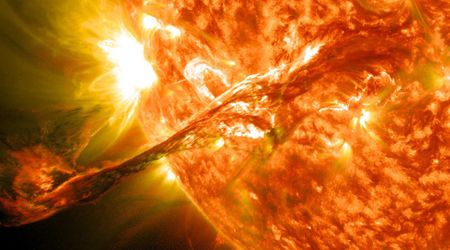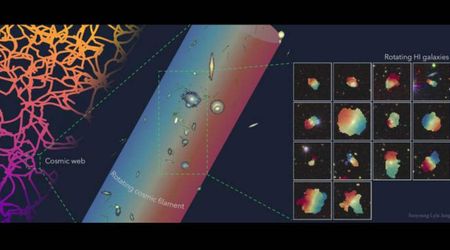In a breakthrough, astronomers capture rare 'olive-shaped' star explosion just a day after detection

Astronomers have finally been able to capture the shape of a star explosion at its earliest, fleeting stage, all thanks to the Very Large Telescope (VLT) at the European Southern Observatory. A team of researchers has documented the first moments of a massive star's death, revealing the initial asymmetrical geometry of the explosion just a day after the detection for the very first time, according to the European Southern Observatory.

The target, supernova SN 2024ggi, lies in the relatively close-by galaxy NGC 3621, at a distance of about 22 million light-years, in the direction of the constellation Hydra. When the stellar blast was first discovered on 10 April 2024, lead author Yi Yang of Tsinghua University knew he had to seize the moment immediately. A lightning-fast proposal to the ESO ensured that the VLT slewed onto the supernova just 26 hours after its discovery.

This rapid reaction required astronomers to use a technique called spectropolarimetry to gather information about the geometry of the explosion before it interacted with the material around the dying star. Regarding the southern hemisphere, this technique is currently only available with the FORS2 instrument at the VLT. According to co-author Lifan Wang, a Texas A&M professor and former ESO student, any other method would have proved inadequate considering the extremely small angular scales. It was because of spectropolarimetry that the team was able to collect clues about the shape of the explosion from the polarization of light despite the exploding star appearing as a single point.
According to the study published in Science Advances, the team found the earliest blast of ejected material was shaped like an olive. And while the shape flattened as the explosion came in contact with the surrounding material, the axis of symmetry remained the same. "The geometry of a supernova explosion provides fundamental information on stellar evolution and the physical processes leading to these cosmic fireworks," Yang said.

It's of immense importance, especially considering how hotly debated the mechanisms behind the explosions of massive stars (at least 8x the mass of our Sun) are. The progenitor of SN 2024ggi was a red supergiant star with a mass between 12 and 15 times that of the Sun, hence a perfect representative of such a phenomenon.

The fact that the explosion initiated with well-defined axial symmetry implies a common physical driver behind many massive stellar explosions. This new geometric data is helping astronomers immediately rule out some of the existing models of supernovae and refine current theoretical frameworks.
Meanwhile, a single, extensive survey by NASA's Nancy Grace Roman Space Telescope is aiming to explore 100,000 cosmic explosions, which encompasses everything from stellar deaths to the violent processes of matter being consumed by feeding black holes. This ambitious observing program, the High-Latitude Time-Domain Survey, is scheduled to operate over two years. It will repeatedly scan the same large segment of the sky, enabling researchers to compile a comprehensive, time-lapse cosmic film. The dataset could provide an unparalleled window into some of the universe's greatest enigmas, particularly the properties of dark energy, the mysterious force responsible for the cosmos's accelerating expansion.
More on Starlust
NASA’s James Webb Telescope discovers evidence of a black hole formed without a supernova explosion
Nearby supernova explosions could be behind two of Earth's mass extinctions, says new study









